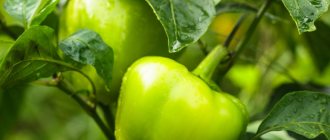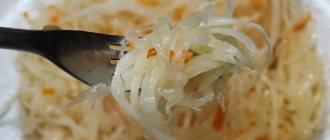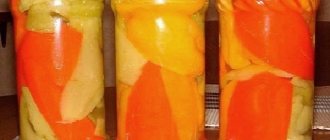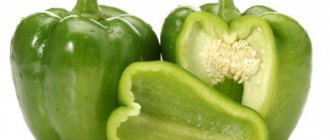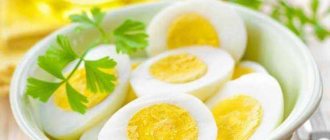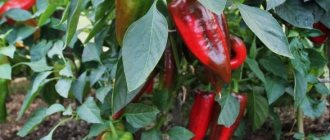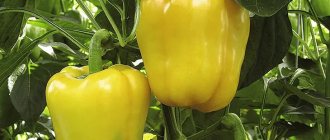Why do sweet peppers grow bitter?
Growing peppers is not as simple a task as it might seem. Sometimes, for example, a long-awaited harvest brings disappointment - for some reason, instead of juicy sweet fruits, bitter ones grow. Why does this happen?
The main thing is to notice the problem in time
Disappointment overtakes the summer resident during the harvest. As, in fact, satisfaction with the fruits of one’s labor. And it’s good if you notice the problem in time. But it happens that, having already stuffed the peppers (the housewife’s signature dish, which has always aroused everyone’s admiration), you suddenly realize that something has gone wrong. A sharp bitterness came from somewhere, which is by no means characteristic of salad juicy peppers...
The phenomenon when bell peppers take on a somewhat elongated shape and become unbearably hot is quite widely known. The main reason for this is common mistakes in agricultural technology.
Secrets of making classic stuffed peppers
15 March 2021, 17:00
Stuffed peppers are bright, appetizing, with juicy meat filling, rice or vegetables. Everyone loves this light but satisfying dish! How to prevent peppers from falling apart during cooking? Why does the meat filling fall out? What can I do to prevent the rice from being hard? How do sweet peppers turn bitter and how to avoid it?
The answers to all these questions are in today's recipe.
Useful tips
- To stuff peppers, rice must be boiled until half cooked.
- Fresh ground peppers near the stalk have a sweet and bitter smell.
- To get rid of bitterness, soak the peppers in cold water for 15 minutes.
Ingredients
- Ground green pepper - 5 pcs;
- Short grain rice - 150 g;
- homemade minced meat - 400 g;
- onion - 300 g;
- carrots - 200 g;
- vegetable oil - 50 g;
- parsley - 1 bunch;
- dill - 1 bunch;
- tomato paste - 200 g;
- meat broth - 800 ml;
- sour cream 25% – 200 g;
- black pepper - to taste;
- salt - to taste.
Recipe
1. To prepare traditional stuffed peppers, we start by preparing the vegetables. We cut off the caps of ground peppers, carefully remove the seeds with partitions with a teaspoon and lower them into cold water for 15 minutes.
2. Meanwhile, rinse the rice until the water becomes clear, and set the cereal to cook on the stove for 10-15 minutes until half cooked.
3. Fry finely chopped onions in vegetable oil until they become transparent. 4. Grate the carrots on a coarse grater and sauté with the onions. 5. Add half of the sautéed vegetables to the homemade minced meat. 6. Add there the rice, boiled until half cooked, previously washed in warm water. 7. Add tomato paste to the remaining onions and carrots in the pan and fry again for 3 minutes.
8. Pour in the meat broth, bring to a boil and reduce the heat. At the very end, add sour cream and finely chopped herbs to the sauce. Season with salt and pepper to taste. 9. Densely stuff the ground peppers soaked in cold water to the top and place them in a pan in one row. This will ensure they cook evenly.
10. Pour the prepared tomato-sour cream sauce on top and simmer for 30 - 40 minutes.
Bon appetit!
Causes of bitterness in peppers
In principle, there is only one reason for the appearance of bitterness in sweet peppers – cross-pollination. This crop is self-pollinating, that is, insect activity is not required for fruit set. However, the possibility of cross pollination, characteristic of other plants, cannot be excluded. That is, if, due to weather conditions or the work of bees, pollination occurs, say, with hot pepper, then the fruits that set will acquire a bitter taste. Seeds taken from a pollinated bush will also produce plants that produce bitter fruit.
Let us systematize the causes of bitterness:
- seeds are taken from pollinated plants - even in a store;
- a bush of hot pepper has fallen into the middle of the garden bed - this reason is relevant when purchasing seedlings at the market;
- Hot peppers are grown nearby, causing cross-pollination.
How to avoid cross-pollination of peppers?
Of course, it is impossible to control the quality of seeds in a store, just as it is impossible to know for sure whether the description of seedlings when purchased at the market corresponds to reality - it is impossible to distinguish between hot and sweet pepper bushes by sight. However, there is a way out:
- buy seeds only from those companies in whose integrity and the quality of their products you are completely confident;
- it is advisable not to buy seedlings on the market, but to grow them yourself from seeds produced by a reliable agricultural company or obtained from your own garden bed - in compliance with technology;
- grow only sweet peppers on the site or, if you need hot ones, plant them at a considerable distance.
By following these simple rules, you can be guaranteed to get a harvest of sweet peppers that are not spoiled by bitterness.
Why is bell pepper bitter, how to remove and prevent bitterness
So, the first thing that comes to mind is cross-pollination. Indeed, there are recommendations that there should be a distance of at least 5 - 7 m between sweet and bitter varieties. However, experienced gardeners have long noticed that this is not enough. The thing is that sweet sticky pollen settles on the paws of bees and insects, which can carry it far beyond the established distance.
Positive traits
The beneficial properties of this product are difficult to overestimate. It has a beneficial effect on human health, promotes rejuvenation of the body, and weight loss.
In this article we will talk about such an interesting product as red pepper, the benefits and harms of which are already quite well known. This subshrub fruit is currently widely used in cooking, medicine, and also in cosmetology.
Fragrant
Like black pepper, it also comes in both peas and ground. But from a botanical point of view, this is not a pepper at all - it comes from the myrtle family. It is made from still green, unripe berries collected from trees up to 20 meters high. You can use it in almost any dish, but be careful - it is very spicy. But also fragrant. The spiciness of these peppers comes from pimento oil, which is also widely used as an aromatic substance.
Anatoly Gendin, gastronomic journalist, writer and blogger:
— Among the pepper dishes popular in Russia, there is no famous Serbian ajvar. This is an absolutely fantastic vegetable caviar made from sweet peppers. For her, the type of pepper itself is very important - slightly spicy, but not too hot, red and fleshy. That’s what it’s called – Crvena mesnata paprika. Ajvar is prepared in huge flat frying pans, where peppers, previously baked over coals and peeled of seeds, internal membranes and skin, cut lengthwise into strips, are stewed with onions, garlic and spices. However, the recipe may differ. One of the popular versions of ajvar is prepared without onions.
Article on the topic
Bulgarian lecho, honey sauce. What can you prepare from peppers for the winter?
They also add fine shavings of horseradish, which gives the final product a subtle piquant note in aroma and taste. The recognizable tomato-like color of the finished caviar comes solely from the pepper itself - there are no tomatoes in traditional ajvar. But there are also exceptions. In Serbian cookbooks there is also a separate recipe for ajvar made from peppers and tomatoes. It should be self-critically admitted that our peppers are not suitable for this colorful Balkan dish. It is no coincidence that the few restaurants serving Serbian cuisine in Moscow claim that they bring ajvar from its historical homeland. Usually it is served in some nice ceramic bowl or simply on a saucer. Try a combination of ajvar with kaymak and white or brown bread - you will surely find a combination that suits your taste. If you are in Serbia, be sure to buy a jar or two of homemade ajvar at the market. Even if the label says “ljuti” (“fierce”, “spicy”), most likely it will only be spicy.
Pepper boy is sweeter. Pepper boy and girl, which one is sweeter
Do you like the crunch of fresh peppers? Then plant the thickest varieties and hybrids. They are ideal for salads, canning and freezing.
One of the most beloved pepper varieties among gardeners is the Star of the East pepper. There are varieties of red and yellow flowers. The variety is very productive. From each bush you can pick up to 12 fruits, each of which weighs up to 260 g! And the wall thickness is 8-10 mm. The fruits are well stored and can withstand long transportation. Productivity is highly dependent on care, and if you do not have the opportunity to regularly care for it, it is better to choose less capricious varieties.
Peppers from the Bull series are very good, with red, yellow and black colors... The fruits are so huge that the bushes simply fall from the weight of the ensuing harvest. Therefore they have to be tied up. It’s very disappointing when fruits are pierced by cutworms. Therefore, it is necessary to spray with Herold or Golden Spark. Fortunately, the harvest, having ripened, can calmly hang on the bushes for another two to three weeks. Wall thickness up to 12 mm!
The California Wonder truly lives up to its name. Productivity is almost record high. There are 10 fruits on the bushes. Productivity per square meter up to 10 kg. Despite its overseas origin, the California miracle feels great both in the middle zone and in the arid South. True, in hot weather you need to water the bushes two to three times a week.
The Golden Miracle variety is not at all similar to the “Californian”. Juicy, aromatic peppers with walls up to 8 mm thick are disease-resistant, set well and produce good yields in cold weather. A reliable variety, not sensitive to the vagaries of the weather.
Do you want to grow peppercorns more than 20 cm long and weighing about half a kilogram? Then land the Red Giant. There will be at least ten such giants on the bush. So it is not difficult to calculate the harvest. True, the bushes of this variety are rather large and take up a lot of space. The taste of the fruit is excellent, the wall thickness is 8-9 mm. It’s simply a shame to cut such beauties into salads.
The pepper hybrid Red Baron F1 is different. It is early ripening and produces a harvest when other varieties are just beginning to bloom. This hybrid is resistant to viruses and fungal diseases. Peppercorns are juicy, weighty, 180-230 g each, good both fresh and in various canned foods.
The Sun of Italy is a recognized hero among yellow-fruited pepper varieties. The weight of peppercorns is up to 500 g, the thickness of the walls is up to 8-9 g. It is better to try the harvest once than to hear about it a hundred times. The taste is unusual, the aroma is strong. The fruits are used for processing and fresh consumption.
The fat man is not very large. But the thickness of its walls exceeds 1 cm. The fruits are juicy and fleshy, have high transportability and a beautiful appearance.
LiveInternetLiveInternet
-Music
—Categories
- display of goods (49)
- grocery (41)
- non-food (8)
- quotes (4)
- astronomy (36)
- knitting (46)
- cities, countries (33)
- dacha (1010)
- pests, beneficial (60)
- children (6)
- design, decor (84)
- inventory, tools (41)
- calendars, crop rotation, books (56)
- medicinal, green (32)
- vegetables (206)
- fruits and berries, conifers (42)
- crafts, tips (43)
- buildings, repairs (53)
- soil (15)
- fertilizer (56)
- companies (73)
- flowers (142)
- what to cook (32)
- berries (43)
- unusual (0)
- children (46)
- education (6)
- cartoons (12)
- training (16)
- school (1)
- for diary, box (41)
- blanks (70)
- adjikas, ketchups (9)
- jam, puree (6)
- freezing (8)
- pickling (23)
- pickling (31)
- salads, caviar (3)
- juices, drinks (4)
- drying (9)
- health (139)
- prevention (118)
- care (13)
- apartment (101)
- bathroom (7)
- children's (3)
- ideas (11)
- kitchen (7)
- clothes, shoes (5)
- repair (37)
- building materials (11)
- textiles (2)
- technology (6)
- cleaning (27)
- cooking (482)
- sandwiches (11)
- baked goods (72)
- for children (31)
- cereals, pasta (23)
- dairy, sour milk (14)
- meat (50)
- drinks (39)
- fillings, minced meat, cream (20)
- public catering. menu (79)
- vegetables (53)
- first courses (57)
- post (14)
- dishes (7)
- seasonings (14)
- fish (29)
- salads, cold appetizer (78)
- tips, lessons (13)
- dough (18)
- decoration, serving (12)
- fruits, berries (5)
- bread, lavash (10)
- eggs, caviar (12)
- music (24)
- unusual (78)
- news (70)
- useful tips. (0)
- holidays, religion (18)
- movies (122)
- history (25)
- history (82)
- feature films (17)
- chemistry (10)
- sewing (94)
- machine embroidery (2)
- children (11)
- for women (36)
- for windows (4)
- fashion, styles (18)
- miscellaneous (28)
- repair (7)
—Search by diary
—Subscription by e-mail
— Regular readers
—Communities
-Statistics
Composition and properties
There are many varieties of hot pepper in the world; they differ in the shape of the fruit and the degree of spiciness. The vegetable can be grown both in open ground and at home, which means that it is available to everyone at any time of the year.
Regardless of the variety, pepper has a rich and unique vitamin and mineral composition. It contains vitamins A, B1, B2, B6, C, E, K, PP, beta-carotene, phosphorus, choline, iron, potassium and essential oils. The vegetable also contains a large amount of ascorbic acid.
Per 100 g of product there are:
- proteins – 1.38 g;
- fat – 0.33 g;
- carbohydrates – 7.31g.
The calorie content of the vegetable is only 40 kcal per 100 g.
When you eat pepper, you will feel a very hot, but at the same time pleasant taste. Many people even experience an “addiction” to this spicy vegetable. It is due to the fact that our taste buds react to the burning substance capsaicin and provoke the production of happiness hormones - endorphins.
The product is widely used both in folk medicine and in pharmacology. On its basis, ointments and sprays are made against runny nose and joint pain.

